Art History Exam #2
1/91
There's no tags or description
Looks like no tags are added yet.
Name | Mastery | Learn | Test | Matching | Spaced |
|---|
No study sessions yet.
92 Terms
Pre-dynastic Period (Date and Importance)
c. 5000-2950 BCE
Formation of sociopolitical structures
Early Dynastic Period (Date and Importance)
c. 2950-2575 BCE
Time of consolidation
Old Kingdom (Date)
c. 2575-2150 BCE
Period of turmoil, ruling family deposed, severe drought
First Intermediate Period
Middle Kingdom (Date)
c. 1975-1640 BCE
Turmoil as the Hyksos invade and the ruling family is deposed
Second Intermediate Period
New Kingdom (Date)
c. 1539-1075 BCE
Usurping kings managed to establish brief, tumultuous dynasties but the lond-ruling, stable dynasties of the New Kingdom were over. Foreign conquest followed, with first the persians, the Macedonians, and then the Romans altering the politics and eventually the traditional patterns of Egyptian life.
Third Intermediate Period

Tomb Painting, Hierakonpolis, c. 3500
Heraldic Composition
Kohl
Galean and soot, likely a ceremonial palette or offering to Horus
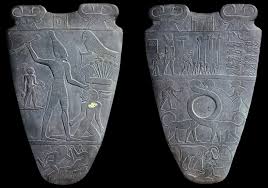
The Palette of Narmer, Hierakonpolis, Early Dynastic period, c.2900 BCE, green schist, 25'“ h
Mastaba Tomb
an ancient Egyptian structure of mud-brick or stone with sloping sides erected over a subterranean tomb-chamber
Serdab
chamber that contained a Ks statue to receive offerings and prayers

Stepped Pyramid of Djoser
Saqqara, Egypt, 204’ tall, limestone
Builder of Stepped Pyramid of Djoser
Imhotep, 2630-2575 BCE
The Great Pyramids
Giza, Old Kingdom, Egypt, c.2575-2450 BCE

Funerary Temple of Hatshepsut
New Kingdom, Egypt, c. 1473-1458 BCE
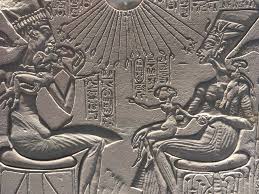
Akhenaten and His Family
New Kingdom, Egypt, c. 1352-1336 BCE
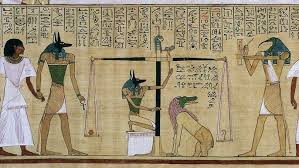
Judgement of Hunefer Before Osiris
New Kingdom, Egypt, c. 1285 BCE

Figure of a Woman
Cyclades, c. 2600-2400 BCE
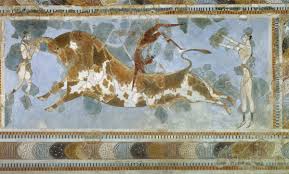
Bull Leaping
Minoan, c. 1700-1450 BCE
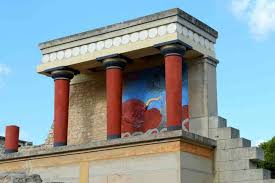
Palace of Knossos
Minoan, c. 1700-1450 BCE
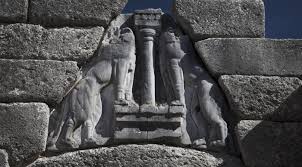
Lion Gate
Mycenaean, C.1250 BCE
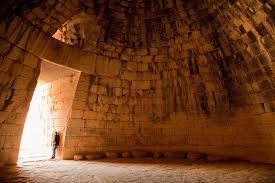
Treasury of Atreus
Mycenaean, c. 1300-1200 BCE
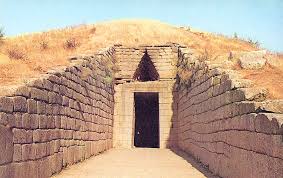
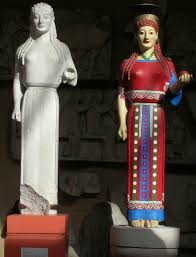
Peplos Kore
Archaic Greece, c. 530 BCE
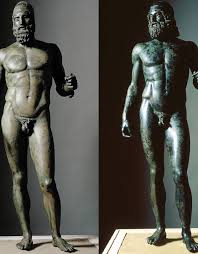
(Riace) Warrior
Classical Greece, c.460-450 BCE
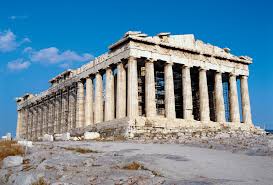
Kallikrates and Iktinos
Parthenon, Classical Greece, c. 447-432 BCE
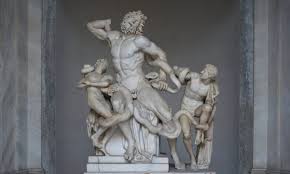
Lacoon and His Sons
Hellenistic Greece, 1st c BCE or 1st c. CE

Master Sculptor Vulca, Apollo
Etruscan, 510-500 BCE
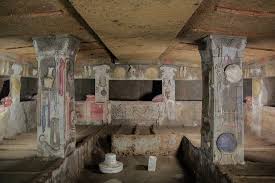
Burial Chamber, Tomb of the Reliefs
Etruscan, Italy, 3rd c. BCE
Sarcophagus
A stone coffin, often decorated with inscriptions and reliefs, used to house and protect a mummified body.
Hieroglyphs
The formal writing system of ancient Egypt, using pictorial symbols to represent sounds, words, or ideas.
Canon of Proportions
A set of ideal mathematical ratios used by Egyptian artists to create consistent, standardized human figures—ensuring uniform body proportions in art.
Nemes Headdress
A striped head cloth worn by pharaohs, draping over the shoulders and tied at the back, symbolizing royal authority.
Composite Pose
A conventional artistic style showing the human body from multiple viewpoints at once—typically the head and legs in profile, but the torso frontally.
Mastaba
An early type of Egyptian tomb with a flat roof and sloping sides, built over a burial chamber underground.
Stepped Pyramid
A pyramid made of several mastaba-like layers stacked on top of each other; the earliest large-scale stone construction in Egypt (ex: Djoser’s pyramid).
True Pyramid
A pyramid with smooth, angled sides that converge to a point at the top—developed after the stepped pyramid to symbolize the sun’s rays.
Ka
The spiritual life force or soul in Egyptian belief, which continued to live after death and required offerings and a preserved body.
Ka Statue
A sculptural representation of the deceased that served as a physical dwelling place for the ka if the body was destroyed.
Serdab
A small sealed chamber in a tomb that housed the ka statue, often with small openings to allow the ka to observe rituals.
Necropolis
Literally “city of the dead”; a large burial ground or cemetery complex associated with ancient Egyptian cities.
Ashlar Masonry
A type of building construction using precisely cut, squared stone blocks laid in even courses without mortar.
Rock-Cut Temple
A temple carved directly into natural rock formations or cliffs rather than built as a freestanding structure.
Axial Plan
An architectural layout organized along a straight central line (axis), leading from the entrance through successive spaces toward a sanctuary.
Hypostyle Hall
A large hall filled with columns supporting a roof, common in Egyptian temples (e.g., Karnak Temple).
Pylon
A monumental gateway to an Egyptian temple, characterized by massive sloping walls and a central doorway.
Books of the Dead
A collection of funerary texts containing spells, prayers, and instructions to help the deceased navigate the afterlife.
Ankh
An ancient Egyptian symbol shaped like a cross with a loop at the top, representing life and immortality.
Cyclopean Masonry
A style of construction using massive, irregular limestone boulders fitted together without mortar; called “Cyclopean” because later Greeks believed only the mythical Cyclopes could have moved such huge stones.
Rhyton
A ceremonial drinking or pouring vessel, often shaped like an animal or human head, used in ritual libations.
Repousse
A metalworking technique in which a design is hammered into relief from the reverse side of a metal sheet.
Megaron
The main hall or throne room in a Mycenaean palace, featuring a rectangular layout, a central hearth, four columns, and a front porch with columns.
Tholos (or Beehive Tomb)
A circular underground tomb built with corbeled stone layers that form a high domed roof, resembling a beehive in shape.
Corbeled Vault
An arch-like structure created by overlapping layers of stone (corbels) that gradually project inward until they meet at the top, forming a vault or dome without true arches.
Black-Figure Ceramics
A style of Greek pottery decoration (6th century BCE) where figures were painted in black slip on a red clay background, then details were incised to reveal the red beneath.
Red-Figure Ceramics
The reverse technique (late 6th century BCE), where the background was painted black and the figures were left in red, allowing for greater detail and naturalism with painted lines.
Caryatids
Sculpted female figures used as architectural supports in place of columns or pillars (famous example: the Erechtheion on the Athenian Acropolis).
Entasis
A slight convex curve in the shaft of a column, designed to correct the optical illusion of concavity and make the column appear straight and more dynamic.
The “Canon” of Polykleitos
A set of ideal mathematical proportions for the human body developed by the sculptor Polykleitos, emphasizing balance, symmetry, and harmony (exemplified in his statue Doryphoros (Spear Bearer).)
Cella (or Naos)
The main interior chamber of a Greek temple that housed the cult statue of the deity.
Portico
A covered entrance or porch supported by columns, leading to the entrance of a building.
Colonnade
A row of columns supporting a roof, entablature, or arcade—commonly seen around temples or courtyards.
Archaic Smile
A slight, closed-mouth smile seen on sculptures from the Archaic period of Greek art (c. 600–480 BCE), used to suggest that the subject was alive and well.
Kouros
A free-standing statue of a nude young man, representing idealized youth and athleticism.
Kore
A free-standing statue of a clothed young woman, often serving as a votive offering to a goddess.
Contrapposto
A pose in sculpture where the figure stands with weight on one leg, causing a natural shift in the hips and shoulders—creating a sense of movement and relaxed balance.
Agora
The central public space in ancient Greek cities, used as a marketplace, gathering place, and civic center for political and social life.
What happened to the Etruscans?
The Etruscan civilization (in central Italy, roughly 900–100 BCE) gradually declined as Rome rose in power. By the late 4th century BCE, Etruscan cities were absorbed into the expanding Roman Republic. Their language and many cultural practices faded, but their art, religion, and engineering heavily influenced Roman culture.
What was Etruscan political structure like?
Etruscan society was organized into independent city-states, each ruled by a king or powerful aristocratic families. They occasionally formed leagues for mutual defense but never unified politically.
Describe Etruscan religious practices.
Highly ritualistic and focused on interpreting divine will through omens, augury (reading the flight of birds), and haruspicy (examining animal entrails). They believed gods influenced every aspect of life, and these beliefs strongly shaped early Roman religion.
Where was the sculpture on an Etruscan temple located?
Unlike Greek temples (which placed sculpture in pediments), Etruscan temple sculptures were on the roof, especially along the ridgepole, and often made of painted terra cotta.
Terra Cotta
A type of baked clay used by the Etruscans for sculpture, architectural decoration, and sarcophagi because it was lighter and cheaper than stone.
Sarcophagus
Etruscan sarcophagi often featured reclining husband-and-wife figures on the lid, showing affection and vitality even in death — emphasizing their belief in a joyful afterlife.
Who ruled Rome before the Romans
Before the Roman Republic (509 BCE), Rome was ruled by Etruscan kings. The last king, Tarquinius Superbus (Tarquin the Proud), was overthrown, leading to the founding of the Republic.
In Cycladic civilization what tool was used to carve marble figures?
Cycladic marble figurines were carved using emery, a very hard stone found on the nearby island of Naxos.
Where are Cycladic marble figures usually found?
They were typically found in burial sites (graves), often placed with the deceased. Their purpose is uncertain — possibly religious, funerary, or symbolic.
Why did the Minoan civilization flourish economically?
The Minoans flourished due to maritime trade, using their central location on Crete to trade with Egypt, the Near East, and mainland Greece. Their wealth came from pottery, textiles, and metals.
What ened the Minoan civilization?
Their decline is often linked to a massive volcanic eruption on Thera (Santorini) around 1600 BCE, which caused tsunamis and destruction on Crete. Later, Mycenaean invasions likely finished their collapse.
What was the written language of the Minoans?
They used Linear A, an undeciphered script, and hieroglyphic symbols. (Linear B, used later by the Mycenaeans, was adapted from Linear A and represents early Greek.)
Why is the Mycenaean culture considered to be more militaristic than the Minoan
The Mycenaeans built fortified citadels (like Mycenae and Tiryns), produced weapons and armor, and depicted warriors and battles in art. Their architecture (Cyclopean walls, Lion Gate) suggests defense was a major concern.
Is there significant evidence to support the Mycenaean culture being more militaristic?
Yes—archaeological evidence supports a more militarized society:
Fortifications around palaces (unlike unfortified Minoan palaces)
Weapons found in graves
Linear B tablets listing chariots and soldiers
However, some scholars argue this view may be exaggerated, since much of what we know comes from elite, fortified centers, not everyday life.
What are the stylistic features of the Amarna Period in Egypt?
The Amarna Period (under Pharaoh Akhenaten, c. 1353–1336 BCE) introduced a more naturalistic and relaxed artistic style. Figures had elongated heads and necks, soft, curving bodies, and intimate, family-oriented scenes. This contrasted with the rigid, idealized forms of earlier Egyptian art and reflected Akhenaten’s religious reforms honoring the sun god Aten.
What are the key characteristics of the Geometric Period (c. 900–700 BCE)?
Art featured abstract, geometric designs and stylized human and animal figures on pottery. This period saw the rise of city-states and the first large-scale figural art since the Bronze Age.
What defines the Orientalizing Period (c. 700–600 BCE)?
Greek art began showing influences from the Near East and Egypt, including floral patterns, mythic animals, and more detailed human forms.
What are the key features of the Archaic Period (c. 600–480 BCE)?
Art became more naturalistic but still stylized. Kouros and Kore figures were common, featuring the Archaic smile. Temples became more elaborate, and black-figure pottery dominated.
What defines the Classical Period (c. 480–323 BCE)?
Art emphasized idealized human forms, proportion, and balance (as seen in Polykleitos’ Doryphoros). Contrapposto became common, and architecture like the Parthenon represented harmony and order.
What are the key traits of the Hellenistic Period (c. 323–31 BCE)?
Art became dramatic, emotional, and dynamic, with twisting poses and intense expression (e.g., Laocoön and His Sons). Artists focused on individuality and realism rather than ideal perfection.
What are the three main Classical Orders in Greek architecture?
Doric Order – The simplest; heavy fluted columns with no base, a plain capital, and alternating triglyphs and metopes in the frieze.
Ionic Order – More elegant; columns with bases and volute (scroll-like) capitals, continuous frieze, and slender proportions.
Corinthian Order – The most ornate; similar to Ionic but with acanthus leaf capitals and greater decorative detail, often used in Hellenistic temples.
What is the function of the entablature in Greek architecture?
The entablature is the horizontal structure supported by columns, divided into the architrave (bottom), frieze (middle), and cornice (top).
What major political event happened in 509 BCE in Rome?
The Romans overthrew the last Etruscan king, Tarquinius Superbus (Tarquin the Proud), ending monarchy and founding the Roman Republic. This marked the transition from Etruscan rule to Roman self-government.
How did the transition from Etruscan to Roman rule affect Roman culture?
Rome adopted many Etruscan artistic and religious traditions (such as temple design, augury, and engineering) but developed a new political identity centered on the Republic and civic duty